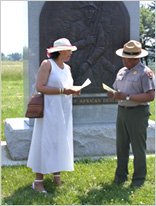CASE STUDY

Conversation on Design, Meaning, and Commemoration in Landscapes – Valley Forge National Historical Park

Valley Forge National Historical Park, located 20 miles west of Philadelphia,
tells the story of the Continental Army's enduring struggle and perseverance
during the winter encampment of 1777-78. The challenge facing the National Park
Service today, is how to utilize the 3,600 acres that make up the park to help
tell the story of what happened there and why it is so significant to our nation's
development, while accommodating the recreational user who jog, walk and generally
enjoy the park's trails and meadows everyday.
|
|

Following the 1777-78 winter encampment of the Continental Army, which devastated the region, the Valley Forge area was quickly restored to agricultural use. It continued as such until 1893 when the Commonwealth of Pennsylvania began to purchase lands to establish the first state park. The State Park Commission partially developed the park along the lines of national military parks, such as Gettysburg, constructing driving routes along lines of defense; inviting other states to erect monuments; and planting commemorative allees and groves. The plans were never fully executed, and little integrity of the original commemorative gestures remains. In addition, all the small-scale features of the original 18th and 19th century farm complexes were lost through demolition and disuse. The commission also demolished most post-encampment structures, including two 18th and 19th century industrial villages.
 |
As a state park, Valley Forge was managed in a traditional park-like manner with manicured lawns, ornamental plantings, and recreational facilities. Over the years, especially as suburban development has enveloped the park, recreation became the dominant use: joggers, cyclists, sunbathers, and horseback riders can be found alongside visitors who come to learn about the historic events.
The National Park Service acquired the park in 1976, and has essentially maintained the status quo. The park landscape that remains, while lovely, is confusing - incomprehensible and fails to tell its own story. Through the general management planning process, the NPS will rethink the design and utilization of the landscape in an effort to tell the story of Valley Forge and its significance in this nation’s struggle for independence.
Full Case Study (PDF) »
Get FREE Adobe Acrobat Reader »

|



